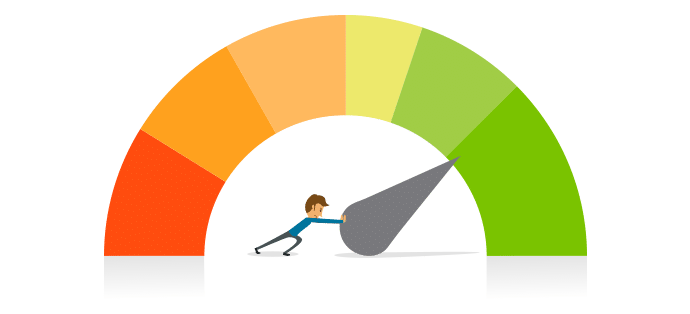Credit Score Ranges
Credit scores play an important role in the American consumer economy by helping lenders determine the risk level associated with extending credit to a particular individual.
The strength of an individual’s credit score will have a direct bearing on the likelihood of being granted credit at attractive terms through various forms of credit such as an unsecured credit card, personal installment loan, auto loan or home mortgage.

Credit scores play an important role in the American consumer economy by helping lenders determine the risk level associated with extending credit to a particular individual.
The strength of an individual’s credit score will have a direct bearing on the likelihood of being granted credit at attractive terms through various forms of credit such as an unsecured credit card, personal installment loan, auto loan or home mortgage.
FICO scores and the VantageScore
FICO scores, created by the Fair Isaac Corporation, range from 300-850 and remain the most widely referenced credit score by lenders today.
FICO produces two types of credit scores – the base FICO score utilized to determine creditworthiness for unsecured credit cards, mortgages and student loans, as well as industry specific FICO scores such as for auto lenders.
FICO scores above 670 are considered good, with scores above 740 considered excellent. The VantageScore, which was developed by the three major credit bureaus (Experian, Equifax and TransUnion), also uses a range of 300-850, with scores above 700 considered good and scores above 750 considered excellent.
Mortgage lenders will often consult the VantageScore because it penalizes late mortgage payments more significantly than the FICO score does.
ABC
How are FICO credit scores calculated?
FICO categorizes its base FICO score ranges through the FICO Score 8 credit-scoring model, which takes into account five primary considerations. To illustrate, payment history is the leading contributor, as 35% of the FICO score is determined by the individual’s ability to make consistent timely payments on all debts.
The fewer late or missed payments, the better the FICO score. The credit utilization ratio contributes a substantial 30% toward a FICO score, and it generally serves the individual to keep this ratio beneath 30% of total available borrowings. Next up, at 15% weighting, comes the length of credit history, and this is measured by the average age of open accounts.
Two further contributing factors, each weighted at 10%, relate to variety of credit – as lenders prefer to see some diversification in the types of credit included in an individual’s profile – and the frequency of “hard pulls” that result from new credit applications, as too many requests for additional debt will negatively impact a credit score.
FICO credit score ranges
Starting from the top, FICO scores of 800 or higher are exceptionally strong and position consumers for easy approval at attractive terms for many forms of credit. Approximately 20% of American consumers have scores in this range.
The second tier, ranging from 740-799, also positions consumers for highly favorable opportunities to secure credit at attractive terms and interest rates.
Remember – credit scores are designed to help lenders assess how risky a potential borrower may be, and for all borrowers with FICO scores of 740-850, there is only a 1% probability that the consumer will fall past due for 90 days or more within the ensuing 24 months!


Next up, a FICO score ranging from 670-739 is generally considered acceptable, though it is worth noting that the 2018 nationwide average FICO score of 695 positions a significant percentage of consumers in this range as below the national average.
FICO scores ranging from 580-669 are considered “fair” and are all below average. Individuals with scores in this range are considered subprime borrowers, implying that they may have difficulty securing credit at attractive terms and will likely be vulnerable to higher interest rates. Indeed, consumers within this range represent a greater risk to lenders, as 27% of consumers with FICO scores in this range are likely to fall past due for 90 days or more within two years.
Things get even worse at the lowest tier, as a FICO score of 579 or lower is considered “poor,” and individuals falling within this range will often be denied credit or subject to unattractive terms and high interest rates. Unfortunately, 62% of consumers with a FICO score in this range are likely to fall delinquent for 90 days or more within two years.
Raise Your Credit Score
If you’re not happy with where your FICO credit score falls within these credit score ranges, take heart. Through careful planning and the implementation of good long-term habits (such as paying all of your bills on time and lowering your credit utilization ratio), you can raise your FICO credit score and climb into a higher credit score range. Read How To Raise Your Credit Score on our website for further guidance that can help you raise your credit score.

Are you in debt? we can help
Get Debt Relief
Speak with licensed debt specialists dedicated to guiding you toward financial stability every step of the way.

Ready To Get Started?
See if you qualify for debt relief. Get a Free savings estimate to see how quickly you can be debt free.
Embrace financial freedom with our tailored solutions, expert guidance, and unwavering commitment to your success.
Experienced Professionals
Our experienced team has helped thousands of clients successfully eliminate debt and regain financial freedom.
Customized Solutions
We know every financial situation is different, so we design personalized debt relief plans to fit your specific needs and goals.
High Success Rate
Our proven debt relief strategies deliver real results. With a strong track record of success, we help clients achieve lasting financial stability.
Confidential Consultation
Your privacy is our priority. All debt relief consultations are 100% confidential and handled with the highest level of discretion.
Explore other blogs











